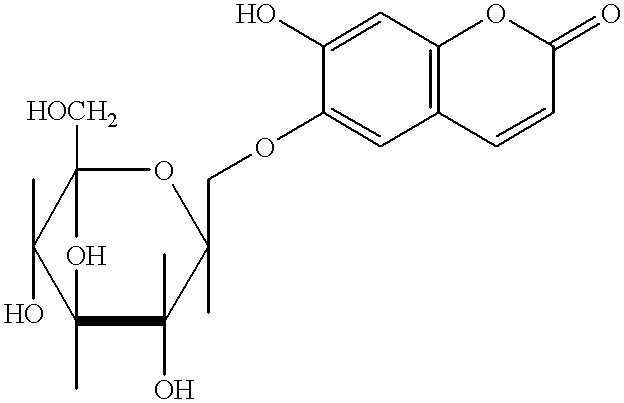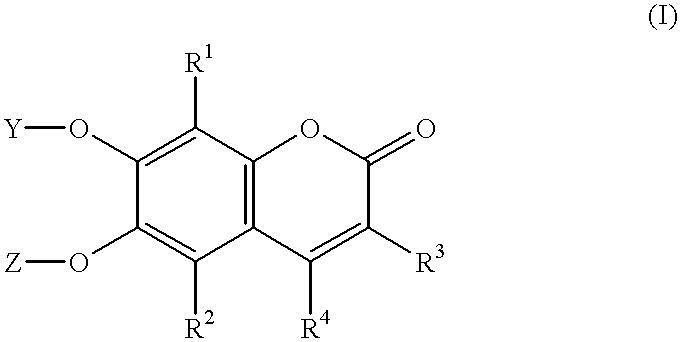Esculetin derivatives
a technology of esculetin and derivatives, applied in sugar derivatives, biochemical instruments, biocide, etc., can solve the problems of complex formation, difficulty in distinguishing individual colonies producing the target enzyme, and difficulty in .beta-glucosidase-producing colonies, etc., and achieves the effect of low diffusion tendency
- Summary
- Abstract
- Description
- Claims
- Application Information
AI Technical Summary
Benefits of technology
Problems solved by technology
Method used
Image
Examples
examples 1 to 4
Synthesis of substituted esculetins (6,7-dihydroxycoumarins)
Materials
Columbia agar was obtained from Lab M, Bury, UK. Chemicals involved in the synthesis of the esculetin derivatives were all obtained from the Aldrich Chemical company Ltd, Gillingham, UK.
example 1
Synthesis of 6,7-dihydroxy-3,4-cyclohexenocoumarin
##STR24##
1,2,4-triacetoxybenzene (6.3 g, 25 mmol) and ethyl cyclohexanone-2-carboxylate (4.25 g, 25 mmol) with heated together in a small flask until a homogenous viscous liquid was obtained. The lowest temperature possible was employed. The hot liquid was cooled somewhat and a magnetic stirrer introduced. Cooling below 30.degree. C. caused solidification and therefore at this temperature 75% w / w sulphuric acid (35 ml) cooled to 10.degree. C. was rapidly added to the stirred liquid. This lowered the temperature whilst maintaining homogeneity. The reaction was allowed to continue at ambient temperature for 6 hours, a white suspension forming after about 3 hours. The suspension was poured in a thin stream into rapidly stirred ice / water (300 ml) and gave a suspension of cream-coloured solid. After stirring for 10 minutes, the solid was removed by vacuum filtration, washed with abundant water, and sucked dry, then air dried at 40-50.degr...
example 2
Synthesis of 6,7-dihydroxy-3-benzyl-4-methyl coumarin
##STR25##
1,2,4-triacetoxybenzene (6.3 g, 25 mmol) and ethyl 2-benzylacetoacetate (5.5 g, 25 mmol) were heated together as described in Example 1. 75% sulphuric acid (35 ml) was added to the stirred solution and stirring continued for 16 hours. The dark coloured suspension was poured into ice / water (350 ml) with good stirring and the grey suspension filtered and the residue washed with abundant water. The residual solid was air dried and recrystallised from hot ethanol with subsequent addition of a little water to aid crystallization. The esculetin derivative formed small white needles (5.5 g, 75.3%).
PUM
| Property | Measurement | Unit |
|---|---|---|
| Fluorescence | aaaaa | aaaaa |
Abstract
Description
Claims
Application Information
 Login to View More
Login to View More - R&D
- Intellectual Property
- Life Sciences
- Materials
- Tech Scout
- Unparalleled Data Quality
- Higher Quality Content
- 60% Fewer Hallucinations
Browse by: Latest US Patents, China's latest patents, Technical Efficacy Thesaurus, Application Domain, Technology Topic, Popular Technical Reports.
© 2025 PatSnap. All rights reserved.Legal|Privacy policy|Modern Slavery Act Transparency Statement|Sitemap|About US| Contact US: help@patsnap.com



